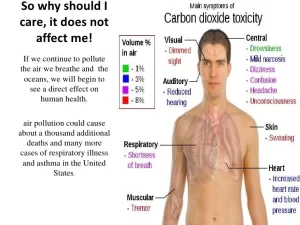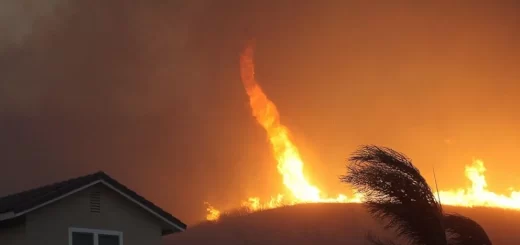What are carbon dioxide disadvantages? and Harmful Effects of carbon dioxide on the environment
Carbon dioxide gas can be toxic and very harmful to humans, It increases the temperature of the Earth’s atmosphere, It causes the global warming effect that has bad effects on the Earth.
Carbon dioxide harms
While CO₂ is a naturally occurring gas that is essential for life on Earth, its excessive accumulation due to human activities poses significant environmental, health, and economic challenges. Reducing CO₂ emissions is crucial to mitigating these disadvantages.
Increasing the percentage of carbon dioxide gas in the air causes suffocation of living organisms as well as global warming that threatens the existence of life on this planet, a high concentration of carbon dioxide gas causes narcosis.
Carbon dioxide gas level increases to higher than 5 % in the room, this ratio is enough to kill the human being, carbon dioxide gas increases the cerebral blood flow and intracranial pressure.
Increasing the percentage of carbon dioxide gas in the air causes the melting of the snow on the tops of mountains and the two poles causing the rise of the level of seawater, so some coastal towns will drown.
Burning of fossil fuels increases carbon dioxide gas emissions, and it causes a gap in the ozone layer which protects the Earth from harmful rays coming from the Sun when the harmful rays enter the Earth’s atmosphere, it raises the temperature of the planet which is known as the greenhouse effect.
Symptoms of carbon dioxide gas toxicity are high blood pressure, headache, flushed skin, and twitching of the muscles, and at higher levels, man can experience panic, hallucinations, vomited, irregular heartbeat, and potentially unconsciousness or even death due to rising of carbon dioxide concentration in the blood and tissues.
Rising the levels of carbon dioxide gas stimulates the sympathetic nervous system which may be dangerous in some patients already having systemic hypertension or myocardial ischaemia.
Increasing the percentage of carbon dioxide gas in the air reduces alveolar oxygen concentration, and it sensitizes the myocardium to externally administered catecholamines.
Harmful Effects of carbon dioxide on humans and the environment
Carbon dioxide (CO₂) has several disadvantages, especially when it accumulates in high concentrations or contributes to certain environmental and health-related issues.
Carbon dioxide is a significant greenhouse gas, trapping heat in the Earth’s atmosphere, When CO₂ levels rise, more heat is retained, leading to global warming. Increased CO₂ contributes to changes in climate patterns, including more extreme weather events, rising sea levels, and shifts in ecosystems and biodiversity.
CO₂ dissolves in seawater to form carbonic acid, leading to ocean acidification, This process lowers the pH of the ocean, harming marine life, particularly organisms like corals, mollusks, and some plankton species that rely on calcium carbonate to form their shells and skeletons.
Elevated Carbon dioxide levels can indicate poor ventilation and air quality indoors, leading to symptoms like headaches, dizziness, shortness of breath, and impaired cognitive function. In enclosed or poorly ventilated spaces, high carbon dioxide concentrations can cause respiratory problems and, in extreme cases, lead to suffocation.
While carbon dioxide can stimulate plant growth to some extent, excessive levels, coupled with higher temperatures and altered precipitation patterns, can stress crops and reduce agricultural productivity. Elevated carbon dioxide levels can lead to a reduction in the nutrient content of some crops, particularly proteins and essential minerals, affecting food quality and nutrition.
Carbon dioxide-driven climate change can alter habitats, forcing species to migrate, adapt, or face extinction. Changes in temperature, precipitation, and ocean acidity can lead to the loss of biodiversity, affecting entire ecosystems.
Climate change driven by carbon dioxide emissions can cause significant damage to infrastructure due to rising sea levels, extreme weather events, and other climate-related impacts. Increased health problems related to poor air quality and climate change can lead to higher healthcare costs.
Climate change can lead to the displacement of people due to rising sea levels, extreme weather, and loss of livelihood, contributing to social and political instability, Changes in the climate can lead to conflicts over resources such as water and arable land, exacerbating tensions in vulnerable regions.
You can follow science online on YouTube from this link: Science online
You can download Science Online application on Google Play from this link: Science online Apps on Google Play
The properties of carbon dioxide gas
The importance and uses of carbon dioxide gas
The harmful effects of toxic chemicals in the environment
What are the bad effects and health risks of smoking?
Air pollution causes, types, effects, solutions & How to prevent air pollution
Carbon monoxide emissions, sources, effects, uses, poisoning symptoms




